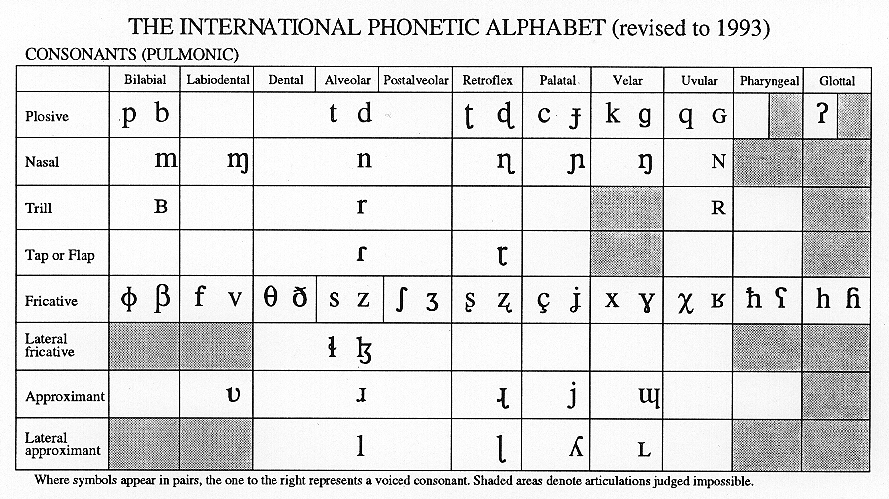More about Non-English Consonants
Take another look at the IPA chart of consonants:  Look for the "series" of consonants - that is, the rows and columns that show how sounds are related. What series have the fewest "holes" - sounds theoretically possible but not actually used? You'll probably notice right away the Fricative series. Remember that these are sounds made by constricting the air flow, though not stopping it, to create friction. This Manner of articulation can occur at any of the Places of articulation, as you see on the chart. Most languages do not, however, use all the Fricatives. English uses /f/, /v/, /T/, /D/, /s/, /z/, /S/, /Z/, and /h/. We don't use the bilabial fricative (to form it, pronounce a /p/ or /b/ and then pronounce it again without bringing your lips closed - like the difference between a /t/ and a /s/ or /d/ and /z/. Nor do we use the retroflex, palatal, velar, uvular, or pharyngeal fricatives. The velar fricative /x/ is found in many languages - the ch in German, Greek, and Scots. The uvular fricative that looks like an upside down R is the French "r". (One of them, anyway.) The bilabial fricative is found in Spanish, I believe - I think the voiced one (symbolized by the Greek letter beta - the B with a tail :-) is in words like "bebe". Another series that is quite "full" is the Alveolar series, those sounds whose Place of articulation is the hard ridge right behind the teeth. English makes use of most of these, excluding the lateral fricatives (I'm not sure what these sounds are - should be an /l/ sound fricativized, meaning with friction added - it may be the "ll" sound in Welsh, but I'm not certain) and - in American English at least - the trill. (American r's are the upside down r you see - the approximant. Some varieties use a retroflex r instead.) Since these two series are "full", they might be a good place to find non-English consonants to use in our language. We must take into account what languages TGL is descended from, though...if English is its ancestor, you might find mostly English consonants in TGL. Or you might find that there had been a sound shift somewhere over the centuries - perhaps some English stops had been replaced with their corresponding fricatives...or certain English nasal sounds separated to include other nasal sounds not found in English...who knows? Another interesting series of consonants, which isn't shown on the IPA chart above (because if you're using the IPA alphabet, you write them with two symbols), is the Africates. English has only two, /C/ and /J/. Africates are easy to figure out: Take a Fricative sound (of which, as we know, there are many), and instead of just pronouncing it as a steady friction-producing obstruction of the air stream, STOP the air stream for just a moment before the friction starts. In other words, it's a stop and a fricative combined. /C/ is /t/ and /S/ combined: you start with the /t/ and flow right into the /S/. /J/ is a combination of /d/ and /Z/. (In the IPA alphabet, /C/ is written /tS/ [not t and S, actually, but the IPA symbols for them...you know what I mean...) and /J/ is /dZ/, that's why there are no IPA symbols for Africates - they can all be written as combinations.) Can we make other Africates from the Fricatives and Stops on the chart? You bet! For example, German has /ts/ - the z in Zehn - and /pf/ - as in Pfennig. /ts/ is also found in Japanese: tsunami. |
Aucun commentaire:
Enregistrer un commentaire